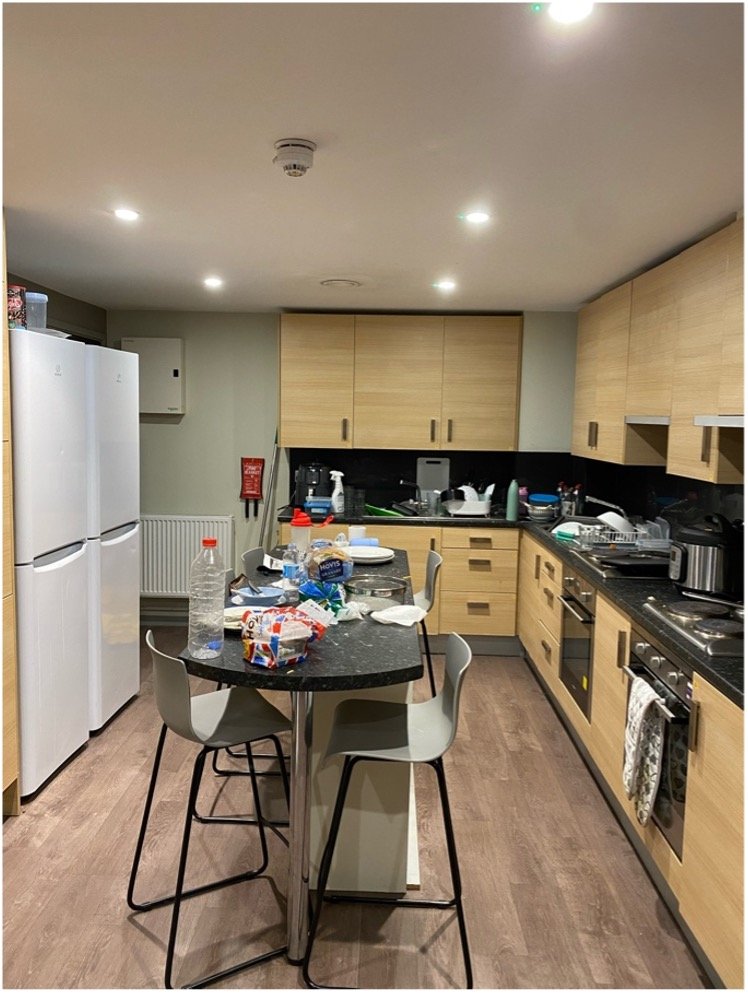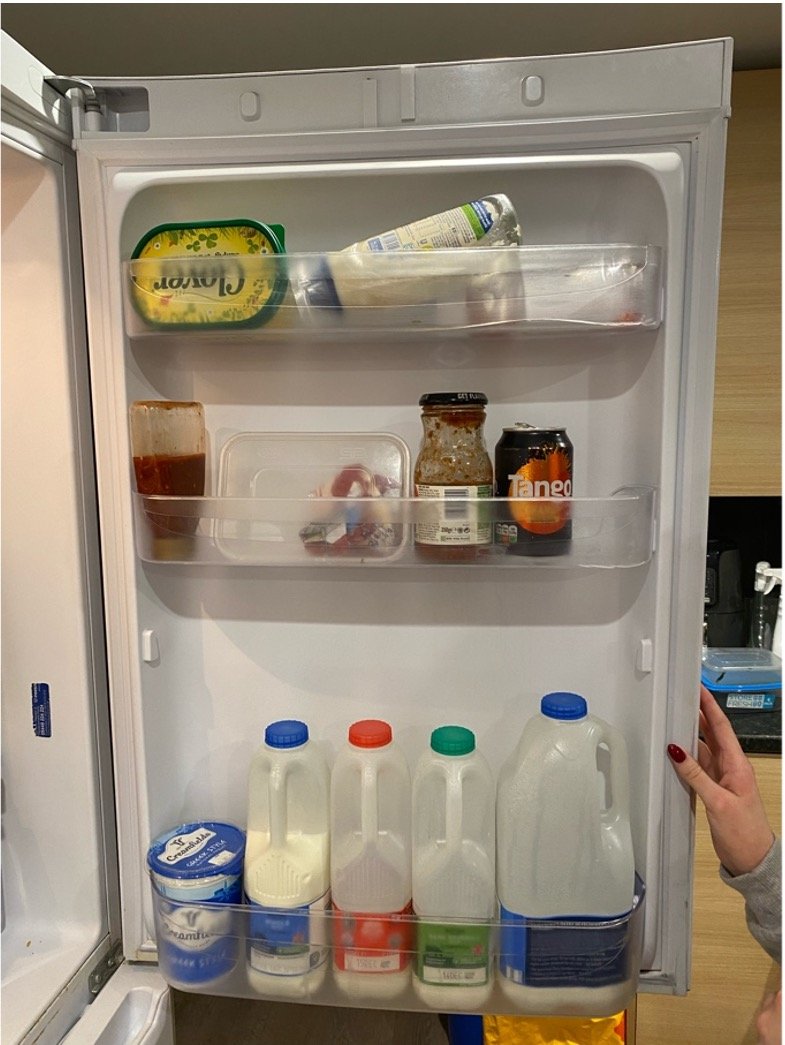The Kitchen: just a place where we make food?
Charlotte Oglesby
I explore the concept of the kitchen, and the relationship that we have with it, through an anthropological lens. Using theoretical ideas such as Bourdieu’s ‘habitus’ to guide this investigation, I consider the role that kitchens play in forming our embodied experience of using space, and the creation of identity. I look at three different examples of kitchens throughout history, and use the comparison to inform my own study of a university hall of residence kitchen. I narrate the experience of visiting it from a personal perspective, and speculate as to how the students have appropriated the space in the process of developing their adult independence.
‘The place I like best in this world is the kitchen. No matter where it is, no matter what kind, if it’s a kitchen, if it’s a place where they make food, it’s fine with me.’
- Banana Yoshimoto (Kellerman, 2010, p.54)
This quote from Yoshimoto’s 1988 novel ‘Kitchen’ is one of my favourite opening lines. Yoshimoto encapsulates how the kitchen holds a unique significance for an individual, and the variations in its form. Whether a central hearth where a family gathers or an alcove in a cramped city apartment with only a single hob, the kitchen is a space that is intrinsically connected to our bodies.
I will explore the manifestations of a kitchen and the relationship that we have with it. I will consider that both the users and the kitchen itself possess agency, as in a symbiotic relationship. Although the kitchen may be regarded as a feminine space and the site of women’s struggle for liberation, I have chosen not to conduct a feminist analysis, although it would be a fruitful area for further research.
Theory from the social sciences will provide a lens for my exploration. I will consider the idea of commensality, and its relationship to the kitchen, before looking at three different contexts of a kitchen. This will inform my research on a university halls of residence kitchen. As a university student myself, I have experience in a similar space, and will investigate it as a transitional place. A discussion will apply these concepts to my research.
Theoretical Background
Given the kitchen’s innate connection to the body, the theoretical lens used in my analysis will centre on embodied experience. I will use phenomenology as a resource, which considers how conditions shape subjective human experience. Phenomenologists such as Heidegger believe that a key condition of humanity is being with others, so the individual is an impossible concept (Zigon & Throop, 2021). Experience is based on the relationships between humans, and non-human entities, which Heidegger refers to as phenomena.
Bourdieu’s concept of habitus will guide understanding of how inhabitants mould a kitchen space, and how they are influenced in turn. A space is appropriated through use and interaction with its materiality. Users develop their identities through the embodied practices of everyday actions. One such embodied practice is cooking: the handling of ingredients and objects, with movement through the space. Another is the process of eating together, commensality. People bring themselves, their experiences and histories to a table, for a shared experience with others.
Commensality
Ethnographic research on the act of eating together has largely been considered in the context of special occasions, with literature on feasting outweighing that on the everyday practice of sharing meals (Nahum-Claudel, 2016). The term commensality is used in subtly different ways, and there is not a consensus on what it entails. It could have come from the Latin ‘commensalis’, literally meaning the sharing of the table (Jönsson et al., 2021). I prefer this interpretation because it comes directly from the built environment, with the table as a facilitator of sharing food. This is the perspective that this exploration will take, where place and food production and consumption are innately linked.
Structuralist thinkers such as Levi-Strauss considered food as a language-like system, determined by an abstract structure (Symons, 1994). In his study of commensal ‘totem-taboos’, he looks at group dynamics and exclusion related to the sharing of food. Mauss considered that commensality creates shared social identities (Warmind et al., 2015). However, neither of these approaches explicitly deal with how the material plays a role in this process.
Simmel considers the meal as representative of human culture in general (Symons, 1994). He argues that we transition from selfish to social beings during a meal, as the act of eating is an opportunity to gather together in a civilised way (Symons, 1994). Simmel’s distinction that human commensality is linked to civilisation implies that it is in some sense the built environment and materials that facilitate our ability to cook, and to eat in a way that differs from other animals. Although this distinction is rather anthropocentric, it allows us to focus on place.
We can also consider food as a mobile material substance, which paradoxically creates a stable sense of place, regardless of location (Petridou, 2001). Thus, commensality ‘involves the creation of a particular space-time through material settings’ (Jönsson et al., 2021). This positions the idea of the kitchen-dining area as a fluid place, not limited to any particular structure.
THE Kitchen as a Site of Consumption
The kitchen varies in form and significance throughout history and across cultures. The following examples illustrate how inhabitants inscribe meaning into the space and thus consume it. Consumption is inseparable from the social structures that govern human experience.
The Kabyle House
Bourdieu’s study of the Kabyle house describes a dwelling used by members of the Berber ethnic group, indigenous to North Africa. He sees the structure in terms of oppositions; the dark side is for sleep and procreation, and the light side is the place of fire, where the hearth is located along with objects created by fire such as the cooking utensils (Bourdieu, 1970). In this structure, there is no separated kitchen: the crucial activity of weaving takes place in the same room as cooking and eating (Bourdieu, 1970).
Bourdieu studies the structure through the everyday routine of inhabitants. The way the Berber people move through the space in their repeated daily acts informs the physical organisation of the house. The oppositions inherent within the physical space as it is used, reflect and reproduce the inhabitants’ view of the world outside (Samanani & Lenhard, 2019).
The Frankfurt Kitchen
The Frankfurt kitchen of Weimar Germany is seen as the pioneer of the modern western fitted kitchen (Parr, 2021). It was designed as a model for housing estates after the First World War (Parr, 2021). These kitchens were small and intended to be as efficient as possible, to reduce the time spent in meal preparation and ensure maximum productive work and leisure time (Parr, 2021).
In Sweden, this model was criticised by women’s groups as antithetical to a family ethos, shutting women out from the family social structure, and so a dining table was added into the kitchen space where a family could come together after a working day (Parr, 2021). These homes were designed solely as a site of production but when it came to families inhabiting the space, there was a need to convert it. The ritualistic value of family time shapes the way that the functional kitchen is inhabited. Intentions were built into the design of these kitchens, but they did not necessarily determine their use.
Soviet Shared Kitchens
Shortly after the revolution, shared kitchens were seen as a popular solution to house the working population in urban Soviet Russia. In a time of state anxiety over dissent, private kitchens could be a threat (Harshman, 2016). Planned shared kitchens were seen as practical and modern, but also allowed neighbours to keep an eye on each other’s activities (Harshman, 2016).
The dynamic of each kitchen would be based on the inhabitants and their interaction with the space and each other. In some cases, relationships between inhabitants were not cohesive. Edward Shenderovich, a Russian poet, recalls that there were “five different kettles, five different pots that are all marked. […] When relations between the neighbours were especially fierce, you could see locks on the cabinets” (The Kitchen Sisters, 2014).
Neighbours separated their practices with individual cooking appliances, desiring privacy within a space where it was contested.
The Student Experience – a Transitory Kitchen?
The student is a unique space. In my own experience of halls of residence, the kitchens are often purpose-built to the same design within a complex. Students rarely stay for more than a year and often treat the kitchen as such.
Kenyon’s ‘A Home from Home’
Kenyon’s 1999 research on the meaning of home for British undergraduate students in Sunderland reveals insights on how students perceive the accommodation. The questions are positioned in comparison to the family home and in many cases, students refer to an imagined future home (Kenyon, 1999). The themes and anecdotes from her interviews give a useful context to my following research.
Kenyon explains how the development into adulthood requires a transitionary stage and for many, this is through the independence of being at university. Around the time of writing, in 1999 25.6 % of all 19 to 20-year-olds in the UK were in full-time further education (Kenyon, 1999). This can be compared to nowadays where, in 2015, 42% of young people were in higher education by 19[1] (UCAS). This trend suggests that university is becoming a key development stage for young people in the UK.
The characteristics of a home, as suggested by these students, could broadly be grouped into three categories: the presence of significant others, a place for autonomy, and something worthy of commitment and investment (Kenyon, 1999). Interviews found that for some, university peers took the place of significant others (Kenyon, 1999). For many, the university home provided more autonomy than the parental home, where they were still subject to their parents’ rules (Kenyon, 1999). However, the student home was not seen as meaningful enough for financial and emotional investment, largely because of its temporary nature (Kenyon, 1999).
FRANK: Our sort of financial input is posters and little cheap things.
ROGER: We are making it a home in that sense, but we are not at the stage where we can afford more… It’s more of a visual thing than anything else.
(Environmental Studies students, ages 18 and 21) (Kenyon, 1999, p.92)
These two students describe their home decoration as ‘visual’, implying that they can only superficially appropriate the space. This idea of only a ‘surface veneer of homeliness’ intrigued me (Kenyon, p.92). It seemed as if the students felt like they couldn’t properly live in student accommodation.
St Pancras Way, UCL
Even though many didn’t feel fully at home in their student accommodation, there is scope to explore how students experience and personalise their kitchen space, as an unconscious or habitual process. To understand more, I visited a student halls kitchen to see how the space was used. Below is an account of my visit:
Figure 1. Floor plan of a kitchen in St Pancras Way halls, UCL
I’m invited to visit a university friend’s hall of residence, just down the road from my shared rented student house. We both go to University College London, but I moved out of university accommodation after my first year. To say I’m glad about this would be an understatement, but I’m excited to see her space in these famously plush new halls. The foyer is easily viewed and accessed from the street, with a receptionist at the desk. As I enter, it feels welcoming. It is decorated in bright colours and the walls are plastered with helpful posters. A key card is needed for access to the rest of the building, and my friend guides me up what seems like a complicated warren of corridors and elevators. Each of the shared corridors has several locked bedrooms along it, and a kitchen at the end. These are devoid of any colour or decoration, purely functional but clean and warm.
On first entrance, I am hit by the smell of a confusing cocktail of past meals. Fuzzy garlic, faint spices and a fishy aroma waft towards me, but not in a wholly unpleasant way. It’s a late afternoon, so the room is empty and the only noise is the slight whir of the radiator. It’s dark outside and all I want to do is curl up on the big black sofa across the far wall. With a TV and speaker adjacent, it is clear that this kitchen has not just been designed as an eating space, but a living space too. I remember that during my own time in halls of residence I craved having a space to relax and socialise like this outside of my box-like bedroom.
The room looked lived-in, to say the least. The sinks were piled high with precariously balanced pots and pans, and plates were strewn across the central table. I got the impression that they had a sporadic strategy for cleaning. The kitchen felt like there might be somebody coming and going at any minute. I could imagine that the plates strewn with crumbs on the table, and the open packets of bread were the result of a rushed breakfast while running late to a 9 am lecture that morning.
A handwritten bin rota was stuck onto the storage cupboard to the right of the fridges, alongside a scoreboard for a competition which I won’t disclose here! Clearly, at least some of the residents were fairly comfortable with each other. Yet the dirty plates left around suggested that different meals had been eaten. Perhaps they ate together, but I could assume that often different food was eaten by each.
All these students had likely arrived at the beginning of the term not knowing each other and with both possessions from their family homes and new ones. Next to each sink was a new-looking air-fryer, both slightly different brands and presumably belonging to different students. I liked to imagine that anxious parents had sent their child off to university with it, hoping to encourage them to cook healthily. The pile of takeaway boxes in the open recycling box suggested otherwise!
As I opened the fridge door I noted with amusement that a whole shelf on the door was taken up by four separate milk cartons with varying bottle top colours. There were also three different brands of spreadable butter and egg cartons, and five different brands of flavoured Greek yoghurt. These were all separated onto different shelves. On the kitchen table, three different opened packets of bread had been left out, and by the sink, there were four separate washing up liquids. This seemed wholly unnecessary to me, but also like a natural act of privacy. It became clear that in their cabinet each student had their own pots and pans, crockery and cutlery, although it was ambiguous from the pile in the sink whose was whose.
In a little nod to Christmas, there was a small decorated synthetic tree, some tinsel hung over a window, and snowflake stickers on the window. Not many personal possessions were left lying around, and I couldn’t picture any of these students in full. I felt like I’d learnt so much about them from this half an hour, and yet also nothing.
Discussion
Without the capacity to interview the students that lived there, my visit relied on sensory perception. I could see traces of people, but had no insight into their subjective experience. Similar to the Frankfurt kitchen, the space was designed to be as functional as possible, but as the kitchen was used the space changed. The conflicting timetables of each student resulted in natural mess and a patchwork appearance.
Knowing this, and with each student coming from a different family home, it was clear that their habits and daily rhythms didn’t match. The separation of the possessions and food is likely influenced by the structure of the kitchen, with each student having a cupboard assigned. The central table provided an opportunity to interact while eating, but the repetition of food in the fridge implied that cooking was done separately. This kitchen is a semi-public space, which inhabitants made somewhat private, much like the shared soviet kitchens. However, the halls differed in that each student was in the same stage of life, and exposed to the same new environment of the university.
The students’ behaviour is partly influenced by social forces. The narrative of independence that is associated with university could contribute to each student taking responsibility for their own nourishment (Holdsworth, 2006). While the family home with its hierarchical structure might have ingrained many habits, the new environment is likely to shape practices in turn. I would argue that the messiness of the student kitchen doesn’t necessarily mean that all the inhabitants are untidy or unclean. The lack of a clear responsibility for cleaning or tidying away could be a factor in the kitchen’s untidiness. The lack of imposed structure in the day and a lack of consequence could be contributing factors to the students’ inclination to leave plates lying around or save washing up for later.
Whatever the specific forces at play, the structure of this kitchen as communal, along with the uniqueness of each students’ prior experience may seem like a dialectical opposition. But the shared involvement in university life more generally constructs a shared social identity for the inhabitants of this kitchen. This identity, along with each students’ possessions and food supplies imbues this space with its meaning. This space is in flux along with the students transitioning identities, and in turn will influence how they perceive their time at university, and shape their dispositions in future houses.
Concluding Thoughts
The kitchen has emerged as a space that is contested. It is a site of habitual, almost ritualistic daily occurrence, but straddles the boundary between public and private, and brings into question individual agency. I have considered the kitchen not as a disembodied structure, but as both the subject and the object of everyday experience. It is a ‘site of memory’, where habits are ingrained into the materiality of the space itself (Meah & Jackson, 2015, p.514). This exploration has contended that we cannot separate an anthropological study of the kitchen into the human and the non-human. It is also almost impossible to study a kitchen by its independent structure. The kitchen itself must be viewed as a mode of self-expression, a space that only turns into a place through the practices of its inhabitants.
[1] This was for England only, so the statistics are not directly comparable, but the huge growth in university places is clear.
REFERENCES
All images author’s own
Bourdieu, P., 1970. The Berber house or the world reversed. Social Science Information, [online] 9(2), pp.151-170. Available at: <https://doi.org/10.1177/053901847000900213> [Accessed 7 January 2022].
Fischler, C., 2011. Commensality, society and culture. Social Science Information, [online] 50(3-4), pp.528-548. Available at: <https://doi.org/10.1177/0539018411413963>.
Harshman, D., 2016. Cooking up a New Everyday: Communal Kitchens in the Revolutionary Era, 1890–1935. Revolutionary Russia, [online] 29(2), pp.211-233. Available at: <https://doi.org/10.1080/09546545.2016.1243616> [Accessed 5 January 2022].
Hernandez, M. and Sutton, D., 2003. Hands That Remember: An ethnographic approach to everyday cooking. Expedition, [online] 45(2), pp.30-37. Available at: <https://www.academia.edu/2158618/Hands_that_Remember_An_Ethnographic_Approach_to_Everyday_Cooking> [Accessed 7 January 2022].
Holdsworth, C., 2006. ‘Don't you Think you're Missing Out, Living at Home?’ Student Experiences and Residential Transitions. The Sociological Review, [online] 54(3), pp.495-519. Available at: <https://doi.org/10.1111/j.1467-954x.2006.00627.x> [Accessed 3 January 2022].
Jönsson, H., Michaud, M. and Neuman, N., 2021. What Is Commensality? A Critical Discussion of an Expanding Research Field. International Journal of Environmental Research and Public Health, [online] 18(6235), pp.1-17. Available at: <https:// doi.org/10.3390/ijerph18126235> [Accessed 4 January 2021].
Kellerman, R., 2010. A Room of Her Own in Banana Yoshimoto’s Kitchen. Pacific Asia Enquiry, [online] 1(1), p.54. Available at: <https://www.uog.edu/_resources/files/schools-and-colleges/college-of-liberal-arts-and-social-sciences/bananayoshimoto.pdf> [Accessed 8 January 2022].
Kenyon, L., 2022. A home from home: students’ transitional experience of home. In: T. Chapman and J. Hockey, ed., Ideal Homes?, 1st ed. [online] London: Routledge, pp.84-95. Available at: <https://doi.org/10.4324/9780203029138> [Accessed 7 January 2022].
Madigan, R. and Munro, M., 1996. `House Beautiful': Style and Consumption in the Home. Sociology, [online] 30(1), pp.41-57. Available at: <https://doi.org/10.1177/0038038596030001004>.
M, A. and Jackson, P., 2015. Re-imagining the kitchen as a site of memory. Social & Cultural Geography, [online] 17(4), pp.511-532. Available at: <https://doi.org/10.1080/14649365.2015.1089587> [Accessed 4 January 2022].
Miller, D. 2001. Introduction. In D. Miller (ed) Home Possessions: The Material Culture of the Home. Oxford: Berg
Nahum-Claudel, C. 2016. Feasting. In: Cambridge Encyclopedia. [online] Available at: <http://doi.org/10.29164/16feasting> [Accessed 7 January 2022]
Parr, J., 2002. Editor's Introduction: Modern Kitchen, Good Home, Strong Nation. Technology and Culture, [online] 43(4), pp.657-667. Available at: <https://www.jstor.org/stable/25148006> [Accessed 5 January 2022].
Petridou, E. 2001. The Taste of Home. In D. Miller (ed) Home Possessions: The Material Culture of the Home. Oxford: Berg
Samanani, F. And Lenhard, J., 2019. House and home. In: Cambridge Encyclopedia. [online] Available at: <https://www.anthroencyclopedia.com/entry/house-and-home>[Accessed 4 January 2022]
Symons, M., 1994. Simmel's gastronomic sociology: An overlooked essay. Food and Foodways, [online] 5(4), pp.333-351. Available at: <http://dx.doi.org/10.1080/07409710.1994.9962016> [Accessed 7 January 2022].
The Kitchen Sisters, 2014. How Russia's Shared Kitchens Helped Shape Soviet Politics. National Public Radio: The Salt, [online] Available at: <https://www.npr.org/sections/thesalt/2014/05/20/314054405/how-russias-shared-kitchens-helped-shape-soviet-politics> [Accessed 7 January 2022].
UCAS, 2015. End of Cycle Report. UCAS Analysis and research. [online] Cheltenham: UCAS, p.12. Available at: <https://www.ucas.com/sites/default/files/eoc-report-2015-v2.pdf> [Accessed 7 January 2022].
Warmind, M., Chou, C. and Kerner, S., 2015. Commensality: From Everyday Food to Feast. 1st ed. London: Bloomsbury Publishing, pp.1-25.
Zigon, J. And Throop, J., 2021. Phenomenology. In: Cambridge Encyclopedia. [online] Available at: <http://doi.org/10.29164/21phenomenology> [Accessed 7 January 2022]




